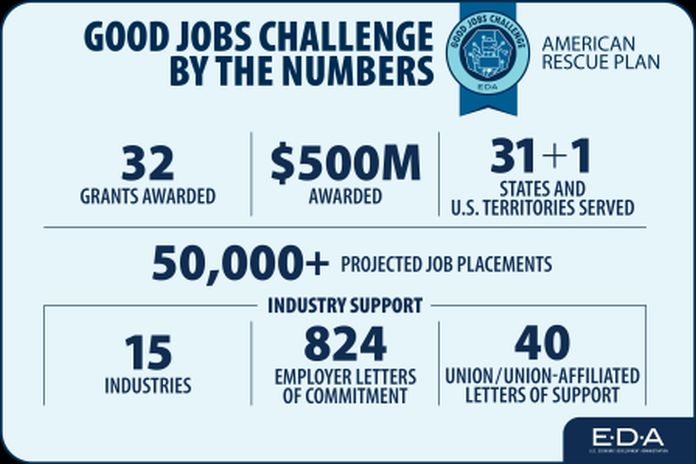By Patrick Bourke, Good Jobs Challenge Program Director
Just last month, over 200 people from across the country gathered together in Washington, DC. They were from state governments, community colleges, and non-profits, representing rural towns, big cities, and everything in between. The one thing they all had in common, they are all partners in this once-in-a-generation investment to place 50,000 Americans into good jobs they wouldn’t otherwise have been able to access. In 2022, the Department of Commerce launched the Good Jobs Challenge in the wake of the pandemic to upskill underemployed individuals and provide job opportunities for those the labor market has historically passed over.
Since 2022, EDA’s GJC grantees have been working to significantly improve the lives and livelihoods of Americans across the country. Since the program’s launch, the GJC has made transformational investments in regional workforce systems and put thousands of Americans into good jobs.
As of December 2023, over 11,000 participants have entered training programs and, as a direct result of the program, over 3,000 people have secured good, quality jobs in high-demand industries like construction, manufacturing, clean tech, forestry, and healthcare. The programs provide training in 31 states and Puerto Rico in 15 different industries.
The program partners with industry to ensure workers receive the training necessary to secure a quality job, eliminates barriers to trainee enrollment by providing wraparound services, and secures employer commitments to hire.
The GJC was originally enacted as part of President Biden’s American Rescue Plan, which began heavily investing in America to rebuild our economy, workforce, and national pride following the COVID-19 pandemic. Secretary of Commerce Gina Raimondo announced the first Good Jobs Challenge awards to 32 regional workforce training systems from across the country in August 2022.
Since then, regional workforce systems, many of which started from scratch, are up and running, scaling their workforce systems, strengthening employer relationships, and providing social services necessary to support participants into a good job.
Driving towards a bright future
One example of success is in southwest Oregon, where the Driving Prosperity training program is leveraging its GJC grant to provide free commercial driver’s license (CDL) training and pay for participants’ licensing fees. The program is also helping participants overcome obstacles by providing language support, transportation assistance to classes, childcare assistance, and additional fee support. The training and wraparound services are allowing students to have the time and money for training, helping them transition into a career in a high-demand, high-paying field. Driving Prosperity is more than halfway towards meeting their overall program job placement goal and is on track to meet that goal this year.
For one worker enrolled in the program, that meant financial assistance and support. After being in training for a week, he expressed concerns about his ability to continue. During his training, program leaders were able to stabilize his housing by making rent payments so that once he started earning his income he would be caught up on bills. Five months after completing his training, the man proudly told leaders he had a savings account and money in the bank for the first time in his life and credits the Good Jobs Challenge with changing his life. Overcoming the hurdles to access a good job is not only important for our trainees, but for their families, their communities, and the resilience and competitiveness of our country.
By collaborating with the private sector, Driving Prosperity is also making a difference for local employers. This year, the trucking industry is estimated to have a shortage of hundreds of thousands of drivers. Southwest Oregon is no exception, and this program will help strengthen the local pool of trained drivers to help meet that need.
Equity
The GJC is creating new opportunities for workers in previously underrepresented industries and reaching communities and individuals who can benefit the most from training.
Participation rates for racial minorities exceed industry trends. For example, Black participation in clean tech, Hispanic participation in IT, and Native American participation in construction exceeds the industry trend.
The GJC also is ensuring success among women in skilled trades. Eighteen percent of participants in GJC-supported skilled trades programs are women, which is significantly higher than the 10-percent national average for women in skilled trades. These programs are increasing the proportion of women in construction, clean tech, manufacturing, and transportation distribution and logistics industries.
Looking ahead
As grantees work to grow and expand their programs, they continue to focus on recruiting diverse participants. It’s imperative that jobs are well aligned to workforce needs and participants are working to ensure that every participant has a good job waiting for them upon completion.
This fiscal year, EDA has been appropriated an additional $25 million in funding for the Good Jobs Challenge, and EDA anticipates releasing a Notice of Funding Opportunity in the coming months. Additionally, president Biden’s FY25 budget requested $41 million for the Good Jobs Challenge to continue EDA’s workforce programming.
We at EDA are proud of the work grantees have achieved to date and know there is more work to be done. The continued funding and vote of confidence from Congress and the administration give us the tools to institutionalize workforce development at the department of commerce, and our Good Jobs Challenge grantees are clearly illustrating why workforce development – and specifically training and placing people into good jobs – is critical to a region’s economic growth.





